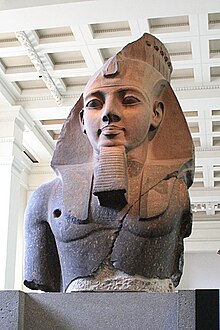Ramesses the Great,
In ancient Greek sources, he is called Ozymandias,[c][10] derived from the first part of his Egyptian-language regnal name: Usermaatre Setepenre.[d][11] Ramesses was also referred to as the "Great Ancestor" by successor pharaohs and the Egyptian people.
For the early part of his reign, he focused on building cities, temples, and monuments. After establishing the city of Pi-Ramesses in the Nile Delta, he designated it as Egypt's new capital and used it as the main staging point for his campaigns in Syria. Ramesses led several military expeditions into the Levant, where he reasserted Egyptian control over Canaan and Phoenicia; he also led a number of expeditions into Nubia, all commemorated in inscriptions at Beit el-Wali and Gerf Hussein. He celebrated an unprecedented thirteen or fourteen Sed festivals—more than any other pharaoh.[12]
Estimates of his age at death vary, though 90 or 91 is considered to be the most likely figure.[13][14] Upon his death, he was buried in a tomb (KV7) in the Valley of the Kings;[15] his body was later moved to the Royal Cache, where it was discovered by archaeologists in 1881. Ramesses' mummy is now on display at the National Museum of Egyptian Civilization, located in the city of Cairo.[16]
Death and burial
The Egyptian scholar Manetho (third century BC) attributed Ramesses a reign of 66 years and 2 months.[66]
By the time of his death, aged about 90 years, Ramesses was suffering from severe dental problems and was plagued by arthritis and hardening of the arteries.[67] He had made Egypt rich from all the supplies and bounty he had collected from other empires. He had outlived many of his wives and children and left great memorials all over Egypt. Nine more pharaohs took the name Ramesses in his honour.
Mummy

Originally Ramesses II was buried in the tomb KV7 in the Valley of the Kings,[68] but because of looting, priests later transferred the body to a holding area, re-wrapped it, and placed it inside the tomb of queen Ahmose Inhapy.[69] Seventy-two hours later it was again moved, to the tomb of the high priest Pinedjem II. All of this is recorded in hieroglyphics on the linen covering the body of the coffin of Ramesses II.[70] His mummy was eventually discovered in 1881 in TT320 inside an ordinary wooden coffin and is now in Cairo's National Museum of Egyptian Civilization (until 3 April 2021 it was in the Egyptian Museum).[71]
The mummy was forensically tested in 1976 by Pierre-Fernand Ceccaldi, the chief forensic scientist at the Criminal Identification Laboratory of Paris. Ceccaldi observed that the mummy had slightly wavy, red hair; from this trait combined with cranial features, he concluded that Ramesses II was of a "Berber type" and hence – according to Ceccaldi's analysis – fair-skinned.[78][79] Subsequent microscopic inspection of the roots of Ramesses II's hair proved that the king's hair originally was red, which suggests that he came from a family of redheads.[80][81] This has more than just cosmetic significance: in ancient Egypt people with red hair were associated with the deity Set, the slayer of Osiris, and the name of Ramesses II's father, Seti I, means "follower of Seth".[82]
However, Cheikh Anta Diop disputed the results of the study and argued that the structure of hair morphology cannot determine the ethnicity of a mummy and that a comparative study should have featured Nubians in Upper Egypt before a conclusive judgement was reached.[83] In 2006, French police arrested a man who tried to sell several tufts of Ramesses' hair on the Internet. Jean-Michel Diebolt said he had gotten the relics from his late father, who worked on the analysis team in the 1970s. They were returned to Egypt the following year.[84]






0 Comments